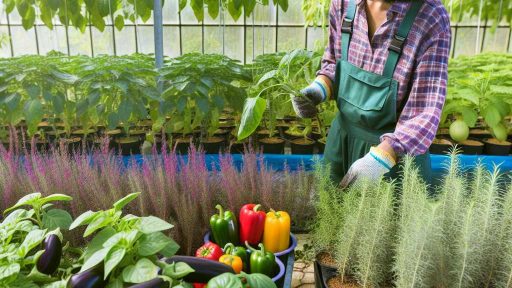Introduction to Organic Farming and Crop Disease Management
Organic farming emphasizes sustainable practices and biodiversity.
It avoids synthetic chemicals and genetically modified organisms.
Investors increasingly recognize the benefits of organic agriculture.
Crop disease management remains a crucial aspect of organic farming.
Effective management practices protect crops and enhance yields.
The Importance of Disease Management
Diseases can devastate crops and reduce marketable yields.
Managing these diseases helps maintain organic standards.
Healthy crops contribute to higher profit margins for farmers.
Investors benefit from lower risks associated with healthy crops.
Common Diseases in Organic Farming
Crops in organic farms are vulnerable to various diseases.
Fungi, bacteria, and viruses can significantly affect plant health.
Common fungal diseases include powdery mildew and blight.
Bacterial infections often manifest as wilts and rot.
Knowledge of specific diseases aids in proactive management.
Strategies for Effective Disease Management
Implementing integrated pest management strategies is crucial.
Transform Your Agribusiness
Unlock your farm's potential with expert advice tailored to your needs. Get actionable steps that drive real results.
Get StartedThis approach combines biological, cultural, and mechanical methods.
Crop rotation disrupts life cycles of pathogens in the soil.
Additionally, resistant crop varieties bolster disease resistance.
Regular monitoring helps detect diseases early on.
Best Practices for Organic Investors
Understanding disease management can inform investment decisions.
Investors should prioritize farms with effective disease control measures.
Adopting sustainable practices improves long-term profitability.
Participating in workshops enhances knowledge about organic farming.
Investors can also network with successful organic farmers.
Understanding Common Crop Diseases and Their Impact on Yield
Overview of Crop Diseases
Crop diseases can significantly affect agricultural productivity.
Pathogens such as fungi, bacteria, and viruses cause these diseases.
Identifying these pathogens is essential for effective management.
Moreover, environmental factors often contribute to disease severity.
Understanding disease cycles helps in preventing outbreaks.
Types of Common Crop Diseases
Fungal diseases are among the most widespread in agriculture.
Examples include powdery mildew and rusts.
These diseases can lead to reduced yields and quality.
Bacterial infections, such as bacterial wilt, also pose risks.
They spread rapidly and can devastate crops if not controlled.
Viruses, like mosaic viruses, weaken plants and hinder growth.
Recognizing symptoms early is crucial for management.
Impact on Yield and Quality
Diseases directly impair crop yield and quality.
For instance, fungal infections can result in significant crop losses.
Additionally, the presence of disease can affect market prices.
Showcase Your Farming Business
Publish your professional farming services profile on our blog for a one-time fee of $200 and reach a dedicated audience of farmers and agribusiness owners.
Publish Your ProfileFarmers may face financial losses due to poor harvests.
Furthermore, diseases can force changes in farming practices.
Crop rotation and resistant varieties are common strategies employed.
Monitoring and Management Strategies
Regular monitoring of crops is crucial for early detection.
Investors should encourage farmers to scout for disease symptoms.
Education on proper cultural practices can enhance disease resistance.
Integrated pest management (IPM) is an effective strategy.
This approach combines biological, cultural, and chemical tools.
Furthermore, investing in research can improve disease control methods.
Key Considerations for Investors
Understanding crop diseases is vital for organic farm investors.
By implementing effective management strategies, yields can be protected.
Investing in knowledge and resources will pay off in the long run.
Integrating Cultural Practices for Disease Prevention
Understanding Cultural Practices
Cultural practices play a vital role in crop disease management.
These methods focus on promoting healthy plants through environmentally friendly techniques.
By integrating these practices, organic farmers can minimize disease incidence.
Soil Health and Fertility Management
Soil health directly impacts plant health.
Regular soil testing should be conducted to assess nutrient levels.
Based on results, organic amendments can improve soil fertility.
Crop rotation enhances soil structure and fertility.
Additionally, cover crops can prevent soil erosion while adding organic matter.
Water Management
Proper irrigation techniques are crucial for disease prevention.
Overhead irrigation can promote fungal diseases.
Instead, drip irrigation delivers water directly to the roots.
This method helps reduce moisture on plant foliage.
Moreover, scheduling irrigation during dry periods can also contribute to health.
Plant Selection
Selecting disease-resistant varieties is essential.
Farmers should choose plants suited for local conditions.
Native varieties often possess natural resistance to local diseases.
Diversity in plant selection can help disrupt disease cycles.
Sanitation Practices
Maintaining cleanliness in the field is vital for disease prevention.
Removing dead plant material reduces the risk of disease outbreaks.
Farmers must sanitize tools and equipment regularly.
Additionally, implementing proper waste disposal can minimize pathogen spread.
Pest Management Integration
Integrating pest management with cultural practices enhances disease control.
Encouraging beneficial insects can naturally limit pest populations.
Regular monitoring for pests will help in early detection.
Employing traps may also assist in managing pests without chemicals.
Seasonal Timing and Crop Management
Timely planting and harvesting can improve crop resilience.
Farmers should synchronize planting schedules with local climatic conditions.
Moreover, timely weed control prevents competition for resources.
Showcase Your Farming Business
Publish your professional farming services profile on our blog for a one-time fee of $200 and reach a dedicated audience of farmers and agribusiness owners.
Publish Your ProfileDiligent crop monitoring allows for early intervention against diseases.
Discover More: Greenhouse Cultivation for Hydroponic and Soil-Based Farming
The Role of Biological Control Agents in Organic Disease Management
Understanding Biological Control Agents
Biological control agents are organisms that help manage pests and diseases in crops.
They include beneficial insects, nematodes, fungi, and bacteria.
Farmers use these agents to improve crop health naturally.
These organisms can suppress pest populations and reduce disease impact.
Types of Biological Control Agents
Various biological control agents serve different roles in farming.
Predators target specific pests, reducing their numbers effectively.
Parasitoids lay eggs in pest bodies, leading to pest mortality.
Microbial agents enhance plant health by combating diseases.
Furthermore, some agents promote plant growth through nutrient solubilization.
Mechanisms of Action
Biological control agents operate through several mechanisms.
They can directly attack pests or pathogens.
Some agents produce substances that hinder pathogen growth.
Additionally, they may trigger plant defenses against diseases.
Importantly, they help maintain ecological balance in the farm environment.
Benefits of Using Biological Control Agents
Utilizing biological control agents offers numerous benefits.
- They are environmentally friendly and reduce chemical dependency.
- These agents promote long-term pest management strategies.
- They can improve crop yields and quality.
- Moreover, they enhance soil health and biodiversity.
Challenges and Considerations
Despite their advantages, using biological control agents has challenges.
Farmers must understand the life cycles and behaviors of these organisms.
Some agents may require specific environmental conditions to thrive.
Additionally, managing them effectively can demand more planning and knowledge.
Finally, pests may develop resistance to some biological control agents.
Implementation in Organic Farming
Effective integration of biological control agents requires strategic planning.
Farmers should monitor pest populations continuously.
They must also assess the health of beneficial organisms regularly.
Implementing a diverse range of control agents enhances effectiveness.
Furthermore, education and training on their use is essential for success.
Discover More: Best Soil Conservation Techniques for Sustainable Farmland Use
Importance of Soil Health and Fertility in Disease Resistance
Understanding Soil Health
Soil health is fundamental for successful farming.
Healthy soil promotes vigorous plant growth.
Moreover, it enhances the soil’s ability to resist diseases.
Investors should prioritize soil health to maximize crop yields.
Key Elements of Soil Fertility
Soil fertility relies on essential nutrients.
These nutrients include nitrogen, phosphorus, and potassium.
Organic matter also plays a critical role in soil fertility.
It improves soil structure and water retention.
Impact on Disease Resistance
Healthy soils lead to healthier plants.
Consequently, these plants are more resistant to diseases.
Conversely, nutrient-deficient soils weaken crops.
This makes them susceptible to pests and pathogens.
Showcase Your Farming Business
Publish your professional farming services profile on our blog for a one-time fee of $200 and reach a dedicated audience of farmers and agribusiness owners.
Publish Your ProfilePractices to Enhance Soil Health
Implementing crop rotation is one effective practice.
Additionally, adding compost improves soil nutrients.
Cover crops can also protect the soil and enhance its structure.
Moreover, avoiding chemical fertilizers fosters a balanced ecosystem.
Building Soil Microbial Communities
Soil health promotes the growth of beneficial microbes.
These microbes help in nutrient cycling and disease suppression.
Investors can benefit from understanding soil biology.
It is essential for sustainable disease management.
Monitoring Soil Health
Regular soil testing informs farmers about fertility levels.
This enables them to make informed decisions about amendments.
Furthermore, monitoring ensures the prevention of nutrient imbalances.
Healthy soils create a resilient agricultural system, vital for long-term success.
Find Out More: Bridging Precision Agriculture And Real Estate A New Approach To Crop Management
Monitoring and Identifying Crop Diseases
Importance of Early Detection
Early detection of crop diseases is crucial for effective management.
Proactive measures prevent significant yield losses.
This approach ultimately supports sustainable farming practices.
Tools for Monitoring Crop Health
Farmers can utilize various tools for monitoring crop health.
Visual inspections remain a fundamental method in this process.
Moreover, remote sensing technology now offers innovative solutions.
Drones equipped with cameras can capture aerial imagery.
This imagery helps identify stressed areas in crops quickly.
Identifying Common Crop Diseases
Understanding common crop diseases is essential for effective management.
Fungal infections often present themselves with distinct signs.
Leaf spots, wilting, or unusual growth patterns indicate potential issues.
Bacterial infections can cause water-soaked lesions on leaves.
Viruses may lead to stunted growth and color changes.
Diagnostic Techniques
Farmers can implement diagnostic techniques to confirm diseases.
Laboratory analysis provides accurate identification of pathogens.
Field tests using specific kits are also available.
Furthermore, consulting local agricultural extensions can be invaluable.
Utilizing Data for Decision-Making
Data-driven decision-making enhances disease management strategies.
Farmers should record observations consistently for improved insights.
Analysis of weather patterns helps predict disease outbreaks.
Sharing data with local farming networks fosters collective learning.
Uncover the Details: Greenhouse Cultivation for Real Estate Investors

Case Studies: Successful Organic Disease Management Strategies
Integrated Pest Management at Green Valley Farm
Green Valley Farm implemented an integrated pest management strategy.
This approach combined cultural, biological, and chemical methods.
Farmers monitored pest populations regularly to make informed decisions.
As a result, they significantly reduced the incidence of crop diseases.
Crop Rotation Practices at Riverside Organics
Riverside Organics utilized crop rotation to manage diseases.
Showcase Your Farming Business
Publish your professional farming services profile on our blog for a one-time fee of $200 and reach a dedicated audience of farmers and agribusiness owners.
Publish Your ProfileBy alternating crops, they disrupted pathogen life cycles.
This practice improved soil health and minimized pest buildup.
Consequently, crop yields increased over the years.
Natural Remedies at Sunny Acres
Sunny Acres focused on using natural remedies for disease control.
The farm employed neem oil and garlic sprays effectively.
These organic solutions helped reduce fungal infections.
Moreover, the farm fostered beneficial insects to combat pests.
Community Sharing at Harvest Moon Farm
Harvest Moon Farm actively participated in community knowledge sharing.
Workshops on organic disease management strategies proved invaluable.
Farmers exchanged experiences and techniques for success.
This collaboration led to improved practices across the board.
Organic Mulching Techniques at Eco-Green Farms
Eco-Green Farms adopted organic mulching methods for disease prevention.
This technique suppressed weeds and maintained soil moisture.
In addition, mulching created a healthy microenvironment for crops.
Farmers noted a marked decrease in soilborne diseases.
Financial Considerations for Organic Investors in Disease Management
Understanding the Costs
Investing in disease management requires careful financial planning.
Organic farming often incurs higher costs than conventional methods.
These expenses include purchasing organic seeds and eco-friendly pesticides.
Moreover, labor costs can increase due to manual labor requirements.
Data management is essential for tracking these costs effectively.
Budgeting for Prevention and Treatment
Establish a dedicated budget for disease prevention and treatment.
An effective budget can cushion unforeseen financial impacts.
Allocate resources for innovative solutions like crop rotation and cover crops.
Investing in farmer education can also yield significant long-term savings.
Consider collaborating with agricultural experts for tailored approaches.
Seeking Financial Support
Explore grants and subsidies dedicated to organic farming.
Many government programs can offset disease management costs.
Non-profit organizations also provide assistance to organic investors.
Look for partnerships with local agricultural cooperatives.
Networking can reveal additional funding opportunities.
Evaluating Return on Investment
Continuously assess the return on investment for disease management practices.
Compare yields from implemented disease control measures against costs.
Data-driven decisions can enhance profitability and sustainability.
Monitor crop health regularly to evaluate the effectiveness of strategies.
Adjust plans according to changing market demands and conditions.
Planning for the Long Term
Develop a long-term strategy for managing crop diseases sustainably.
Sustainable practices can lower costs and protect the environment.
Invest in soil health to improve resilience against diseases.
Consider diversifying crops to minimize risks associated with specific diseases.
Regularly update your disease management plan to adapt to new challenges.
Showcase Your Farming Business
Publish your professional farming services profile on our blog for a one-time fee of $200 and reach a dedicated audience of farmers and agribusiness owners.
Publish Your ProfileFuture Trends in Organic Crop Disease Management and Research
Advancements in Biotechnology
Biotechnology continuously reshapes organic crop disease management strategies.
Innovative tools improve disease resistance through genetic modifications.
Moreover, researchers explore microbial solutions to enhance plant health.
Integration of Precision Agriculture
Precision agriculture promotes targeted disease management practices.
This method uses data analytics to monitor crop health in real-time.
Farmers benefit from tailored interventions, reducing chemical inputs.
Utilization of Biological Control Agents
Biological control agents are becoming popular in organic farming.
These agents suppress pathogens through natural mechanisms.
Additionally, they enhance soil biodiversity and crop resilience.
Increase in Organic Certification Standards
As demand for organic produce rises, certification standards evolve.
Stricter regulations are emerging to ensure disease management practices are sustainable.
This shift encourages transparency and consumer trust in organic products.
Collaboration with Research Institutions
Farmers and researchers increasingly collaborate to combat crop diseases.
Partnerships foster knowledge exchange and innovation.
These collaborations often lead to the development of new pest management techniques.
Emphasis on Sustainable Practices
Sustainable agriculture remains at the forefront of crop disease management trends.
Practices such as crop rotation and cover cropping build resilient farming systems.
These strategies also help decrease disease incidence and improve soil health.
Additional Resources
Partnerships for Climate-Smart Commodities Project Summaries …




